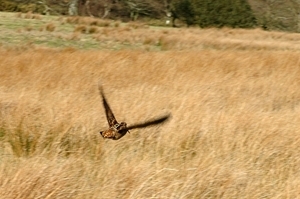Key findings
- Migration strategy – a series of long, fast flights of 600-1,100km (375-690 miles), broken up by stops en route typically lasting at least 10 days.
- Departure times – typically mid-March to early April from winter sites, late September to late October from breeding sites.
- Mixing of migrants at wintering sites – birds tagged at the same winter site often headed to different breeding grounds.
- Extraordinary distances – three birds have travelled distances of 6,180-7,100km (3,860-4,440 miles) to breeding sites in Siberia. One male, tagged as an adult in 2012, is estimated to have flown at least 38,000km (23,750 miles) during his life!
- Journey times – times taken to reach breeding sites have varied from three weeks (northern Norway) to eight weeks (central Russia).
 The GWCT has employed a number of very different tracking devices to study the migration of Britain’s wintering woodcock. Ringing studies and stable isotope analyses had already suggested that these migrant birds, that spend their winter months in Britain, originate from Russia, Finland, Scandinavia and the Baltic States. But tagging woodcock was the only way to get a clear understanding of the timing of migration and the routes taken. As the tracking technology is constantly evolving, different ways of studying migration have arisen as our research progresses, providing an ever-improving insight into their incredible journeys.
The GWCT has employed a number of very different tracking devices to study the migration of Britain’s wintering woodcock. Ringing studies and stable isotope analyses had already suggested that these migrant birds, that spend their winter months in Britain, originate from Russia, Finland, Scandinavia and the Baltic States. But tagging woodcock was the only way to get a clear understanding of the timing of migration and the routes taken. As the tracking technology is constantly evolving, different ways of studying migration have arisen as our research progresses, providing an ever-improving insight into their incredible journeys.
Geolocators
These were the first tags that became available for woodcock. They are much smaller and cheaper than satellite tags and have the potential to yield similar information on migration routes. They work by logging daylight levels, from which the time of sunset and sunrise can be determined. Day hours and the time of relative midday can then be used to estimate latitude and longitude respectively to an accuracy of about 100km, an acceptable margin of error for a bird that may migrate 2,000–6,000km. Geolocators only ‘log’ data, they do not transmit it, so birds’ tags had to be recovered. Return rate of geolocators to date has been about 20%, with both live captures and recoveries from shooting.
Satellite tags
Satellite tags were the first devices available that could provide live updates from tagged woodcock and saw the start of our pioneering Woodcock Watch project. The satellite tags we used weigh 9.5g and are mounted on the lower back using an elasticated leg-loop harness. Each tag consists of a tiny satellite transmitter, a battery and a solar panel to keep the battery charged. In total 65 birds were tagged between 2012 and 2018, across England, Scotland, Wales, the Isle of Man and Ireland. Birds were tracked back to eight different countries of origin (Norway, Sweden, Denmark, Finland, Latvia, Belarus, Russia and Poland), including some Russian breeding birds that travelled over 7,000km to breeding sites in western Siberia.
GPS loggers
These are the most recent tags we have used. Although, like the geolocators, they are unable to transmit, they are by far the most accurate tags available, recording their wearers locations to within a couple of metres. They also have particularly efficient and reliable battery life. These tags are helping us to ‘fill the gaps’ left by the satellite-tagging study, for instance, by gathering autumn migration data when limited opportunity for solar recharge meant previous tracking data were lacking. The fine-scale data these tags gather is so precise it can even allow us to track the habitat use of breeding birds on their continental breeding grounds.